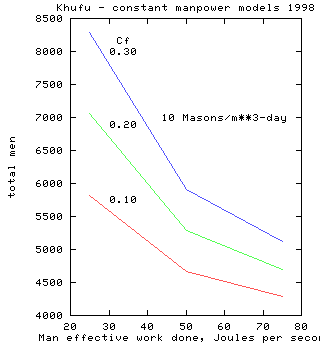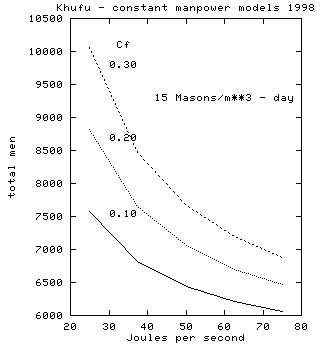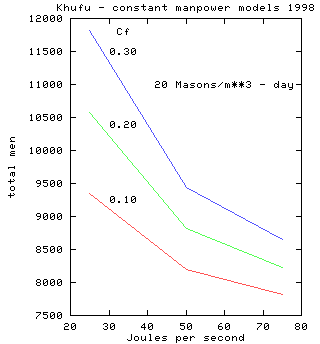This is an extension of work published as Construction of Egyptian Old Kingdom Pyramids. Cambridge Archaeological Journal, 1996, volume 6, issue 1, pp. 150-163.
A great deal of attention has been paid in the past century to particular methods which might have been used to build the ancient Egyptian pyramids. Surprisingly, until the 1990s, no one made any attempt to determine the manpower required to build the pyramids, since Heredotus asked questions at the Temple of Ptah in Memphis in 451 B.C. That was 2000 years after the pyramids were complete. He got an answer of 100,000 men, but as any curious tourist to Egypt knows, the guides can make up anything if the the tourist looks gullible. Who knows if Heredotus's manpower report has any merit? Not a reliable source by current standards. Other significant facts Herodotus reported about the pyramids are now known to be false.
In fact reasonable estimates of manpower can be made knowing only the simplest facts about pyramid construction. My original calculations of pyramid construction rate schedules and manpower requirements were published in the Cambridge Archaeological Journal, volume 6, number 1, April 1996. See also the review by Ian Stewart in Nature, 19 September 1996, page 218, and Stewart's Mathematical Recreations column in the September 1998 issue of Scientific American.
The original work showed how to make estimates of construction rate and manpower requirements for building large simple stone pyramids, based on principles of math and physics, and using as few assumptions as possible about actual building methods. This is similar to estimating the fuel requirements to send an object of known mass to the Moon, assuming only some efficiency of propulsion, and the known distances and gravitional forces, without actually making a space program. The original paper used the surviving intact Old Kingdom Pyramids of Egypt as examples. Manpower to build the pyramid of Khufu, the largest pyuramid, was found to be roughly 8000 to 10000 men over some 23 years.
See the original report for the detailed discussion about this approach. The following update assumes knowledge of the concepts presented there.
During this work it became obvious that three key parameters controlling manpower demands were not well known. They are the coefficient of sliding friction (assuming blocks were slid from the quarry to the building site on prepared trackways), the amount of force-times-distance work the average worker could achieve in one day of work, and the number of masons required to quarry and install a given volume of stone per day.
Of these, the coefficient of friction is easiest to estimate within reasonable limits. Smooth dry wood sleds sliding over smooth wood tracks have a coefficient of friction near 0.20; this can be found in reference books and was also verified with a 1/5 scale model. If the track is lubricated with animal fat, or with clay and water mixed, appropriately called "slip" by potters, the coefficient of friction drops to near 0.10, as verified by the model. In either case if the track becomes gritty with sand the coefficient of friction rises to around 0.3 or even more. Since friction has a immediate and very obvious effect on how many men are required to move the stones, I assume the ancient builders took the simple precautions needed to keep the coefficient of friction down to 0.2 or less (even though they did not think in terms of coefficients of friction).
After the original paper was published I found a better estimate of effective work a man can do in a day (not calories consumed) in "Mark's Standard Handbook for Mechanical Engineers" (McGraw Hill, 1996). The figure is 75 Joules per second for 8 hours per day. Since this is based on contemporary humans, some may wonder if ancient man achieved as much. Personally I think a necessary precondition for building the large pyramids would have been a stable prosperous commnuity that was well fed and not troubled by food shortages or significant heatlth problems. I think it very likely that ancient man could achieve most of what modern man can do in terms of simple physical strength. Nonetheless it is easy to recompute the manpower demands using less work done per man per day.
Finally, there is the question of how many workers were required to quarry and install a given volume of stone. From the known volume of the pyramid and the known time of construction one can easily compute the average rate of construction in cubic meters per day, knowing absolutely nothing about the masonry techniques used. Either the ancient builders acheived the rate computed, or the reports for time to build the pyramids are in error. The only question is how many masons were required to quarry the volume of stone each day indicated by the construction rate.
Masons were needed to remove the stone from the quarry formation and install it on the pyramid, where it was cut to fit neighboring blocks. As initial estimates I used values from 10 to 20 masons per day to cut and install each cubic meter each day. (This does not mean they cut blocks a meter on a side! It is just a proportion.) Less than 10 seems rather efficient; 20 or more men per cubic meter would encumber other workers. As shown below it is easy to determine the total workforce for any numbers of masons required, in case you want to try another range of values.
The present goal is to compute an envelop of workmen required to build the bulk of the Khufu pyramid, known as the Great Pyramid, allowing the three unknown parameters to take on all reasonable values. This is naturally a 3-dimensional envelop in terms of the three parameters discussed. I use the "constant manpower" model of the original paper, a computation method that finds the unchanging number of men required to build the pyramid in the known number of years. To achieve this, the construction rate must vary with time, and workers shift from quarrying to transport as the pyramid raises and the difficulty of moving stone increases. For any given pyramid, construction duration, and constant manpower level there is only one (monotonic) construction rate schedule that will meet the requirements.
The results are shown as three 2-dimensional plots below, where the coefficient of friction varies from 0.10 to 0.30, the daily effective work rate is 25 to 75 Joules/second per worker (33 % to 100 % of the modern figure), and the number of masons required per cubic meter per day varies from 10 to 20.
To use these plots to determine the number of workmen required to build the pyramid for any combination of parameters, first choose the number of masons you like to quarry and install each cubic meter per day. If you choose 15, use the middle plot. Then find the manpower work rate you desire along the bottom horizontal axis on that plot. The go straight up vertically until you intersect the level cooresponding to the coefficient of friction you are interested in. From that point move straight horizontally to the vertical plot axis. The numbers on the vertical axes show the total number of workmen required for the combination of parameters you chose. You can interpolate between the curves shown for parameter values.
The number of workdays has been reduced to 7560, nine-tenths of some 8400 days in Khufu's reign. I suppose they did not work every single day and did not precisely complete the pyramid the day the King died. The 7560 days is only an estimate of the building duration but it is more than adequately precise for the nature of the calculation, and probably a better estimate that some other parameters in the calculation.
The extreme limits of manpower required varies from 4300 men to 11800 over the range of all parameters considered here. The center of all parameter ranges results in 7060 men to build the core of Khufu's pyrmaid in 23 years. This is manpower to build only the bulk of the pyramid, not including manpower for interior passages and chambers, outer casing, transport of special stone from remote quarries, temples and causeways and other related structures, housing, logistical support, or any of numerous related efforts.
Changes in total manpower due to changes in number of masons required can be found from any of the given curves. The average construction rate for this pyramid is 343 cubic meters per day. Adding an additional 5 men for masonry per cubic meter per day simply increases the manpower demand by about 1715 men regardless of choices of other parameters; this increase can be seen on the plots shown. (Small differences from 1715 appear due to the limitations in building at the top of the pyramid.) The set of curves labeled "15 masons/m**3 - day" can be used to construct the other sets of curves, or the curves for any other number of masons desired.
The plot for 15 masons has more points computed, resulting in smoother curves. The other two plots would have similar curves if more points were computed for them.
The plots shown here should provide a guide for estimating the actual manpower demand to build Khufu's pyramid as archaeologists learn more in the future about ancient workers and their techniques.
The fact that the results here are close to those in the earlier reports indicates that the manpower estimates to build other pyramids given in the earlier reports are still valid to the level of accuracy intended. The refined calculation shown here reassures that the results found in all this work are a good estimate of the manpower required to build the large masonary pyramids of the Egyptian Old Kingdom. One unstated assumption here is that the ancients used the smallest number of men that was required. It is possible more were employed at the task, working less efficiently.
The following table shows details for one particular combination of control parameters, by height of uncompleted pyramid during construction, for 15 masons per cubic meter, 0.20 coefficient of friction, 50 J/s average man effective work rate, and 7560 days, to build the Khufu pyramid. Precision used is much higher than the accuracy supported by the information supplied.
Note that, as in the first paper, the construction rate exceeds 350 cubic meters per day for the first twelve years. Any proposed pyramid construction scheme must be able to provide this rate. Also note that more masons are required than other types of workers. Quarrying was likely the most demanding part of pyramid construction, not transporting or assembling the quarried blocks.
The total manpower required, 52 million man days, can be used to provide a rough guide to the cost of building the Great Pyramid in terms of today's money or values. For example, let us pay each worker a wage of $6 per hour, with associated overhead (a modern concept) of $6 per hour. Then the manpower cost is 52 million times 12 dollars times 8 hours per day, about 5.0 billion dollars. The mass of the pyramid is 7 billion kilograms; we assume one has one's own quarry to avoid buying the material on the retail market. A bid on 7 billion kilograms of limestone would get into real money. You would have to be a Pharaoh to afford it.
Pyramid construction with constant labor force.
Khufu Pyramid
height width
146.70 230.36
manrate(J/day) masons/m**3 coef.fric
1440000.0 15 0.20
average construction rate, cubic meters per day
343.24
height cstr.rate days cumDays apcm drag lift masons total
0.0 370.89 142.1 0 143.1 1299 195 5563 7057
5.0 368.23 133.5 693 134.5 1290 243 5523 7056
10.0 365.63 125.1 1343 126.0 1281 292 5484 7057
15.0 363.03 116.9 1952 117.8 1272 340 5445 7057
20.0 360.47 108.9 2521 109.8 1263 387 5407 7057
25.0 357.89 101.2 3050 102.0 1254 435 5368 7057
30.0 355.49 93.7 3541 94.5 1245 480 5332 7057
35.0 353.00 86.4 3994 87.2 1236 526 5295 7057
40.0 350.63 79.3 4412 80.1 1228 570 5259 7057
45.0 348.16 72.5 4795 73.3 1220 615 5222 7057
50.0 345.86 66.0 5144 66.7 1211 658 5188 7057
55.0 343.58 59.7 5462 60.3 1203 700 5154 7057
60.0 341.23 53.7 5748 54.3 1195 744 5118 7057
65.0 338.96 48.0 6005 48.6 1187 786 5084 7057
70.0 336.76 42.5 6234 43.1 1180 826 5051 7057
75.0 334.56 37.4 6436 37.9 1172 867 5018 7057
80.0 332.43 32.5 6613 33.0 1164 907 4986 7057
85.0 330.23 28.0 6766 28.4 1157 946 4953 7056
90.0 328.09 23.7 6897 24.2 1149 987 4921 7057
95.0 326.07 19.8 7008 20.2 1142 1024 4891 7057
100.0 323.96 16.2 7100 16.6 1135 1063 4859 7057
105.0 321.89 13.0 7174 13.3 1128 1101 4828 7057
110.0 319.89 10.1 7234 10.4 1121 1138 4798 7057
115.0 247.78 9.7 7282 10.0 868 916 4708 6492
120.0 175.78 9.6 7331 10.0 616 673 3340 4629
125.0 116.11 9.5 7379 10.0 407 460 2206 3073
130.0 68.77 9.4 7426 10.0 241 282 1307 1830
135.0 33.75 9.2 7473 10.0 118 144 641 903
140.0 11.07 8.5 7518 10.0 39 48 210 297
145.0 1.00 3.1 7556 7.1 4 4 19 27
cummulative days = 7559.7
cummulative volume = 2.590 e 6 cubic meters
cummulative man-days = 52.10 e 6
cummulative mass = 7.006 e 9 kg
cummulative Pot. Engery = 3.79 e12 Joules
cstr rate is construction rate in cubic meters per day.
days is days required to make a layer 1 meter thick at this height
cumDays is number of days to reach this height.
apcm is top working area for each installed cubic meter per day
drag is number of men for horizontal component of transport
lift is number of men for vertical component of transport
total is sum of men for transport and masonry.
Stuart Wier
Send email to
sw
at
westernexplorers dot us
phone 303 499 0991 (US)
Copyright © 1998 - 2015 Stuart Wier
Reproduction, retransmission, redistribution, or reuse in whole or in part prohibited without prior written consent of the author.


